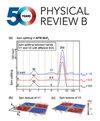How quantum selection rules influence the magneto-optical effects of driven ultrafast magnetization dynamics
IF 3.7
2区 物理与天体物理
Q1 Physics and Astronomy
引用次数: 0
Abstract
Ultrafast magnetization dynamics driven by ultrashort pump lasers is typically explained by changes in the electronic populations and scattering pathways of excited conduction electrons. This conventional approach overlooks the fundamental role of quantum mechanical selection rules, governing transitions from the core states to the conduction band, that form the key method of the probing step in these experiments. By employing fully time-dependent density functional theory, we reveal that these selection rules profoundly influence the interpretation of ultrafast spin dynamics at specific probe energies. Our analysis for hcp Co and fcc Ni at the M edge demonstrates that the transient dynamics, as revealed in pump-probe experiments, arises from a complex interplay of optical excitations of the量子选择规则如何影响驱动型超快磁化动力学的磁光效应
本文章由计算机程序翻译,如有差异,请以英文原文为准。
求助全文
约1分钟内获得全文
求助全文
来源期刊

Physical Review B
物理-物理:凝聚态物理
CiteScore
6.70
自引率
32.40%
发文量
0
审稿时长
3.0 months
期刊介绍:
Physical Review B (PRB) is the world’s largest dedicated physics journal, publishing approximately 100 new, high-quality papers each week. The most highly cited journal in condensed matter physics, PRB provides outstanding depth and breadth of coverage, combined with unrivaled context and background for ongoing research by scientists worldwide.
PRB covers the full range of condensed matter, materials physics, and related subfields, including:
-Structure and phase transitions
-Ferroelectrics and multiferroics
-Disordered systems and alloys
-Magnetism
-Superconductivity
-Electronic structure, photonics, and metamaterials
-Semiconductors and mesoscopic systems
-Surfaces, nanoscience, and two-dimensional materials
-Topological states of matter
 求助内容:
求助内容: 应助结果提醒方式:
应助结果提醒方式:


